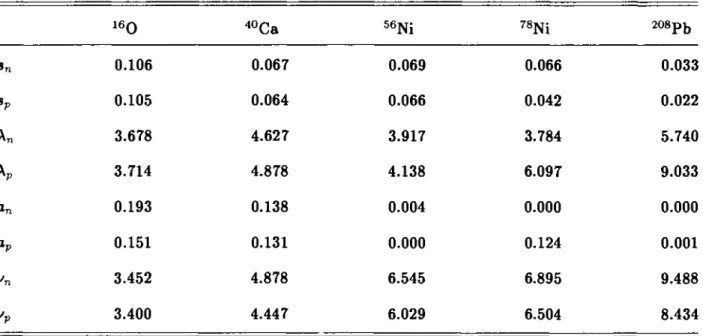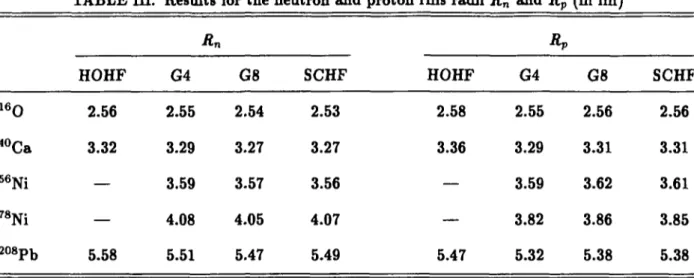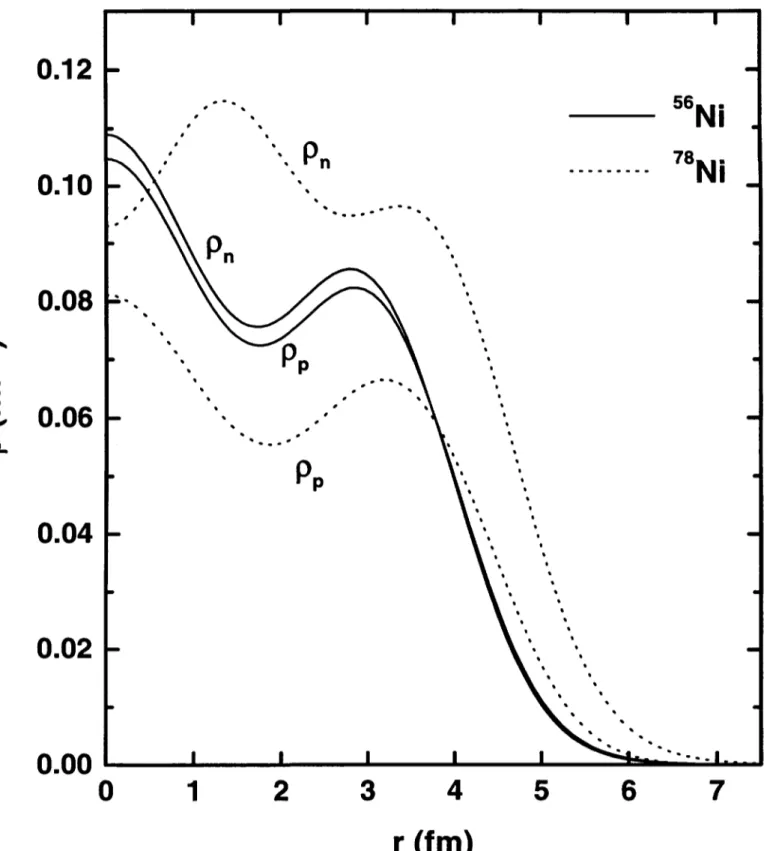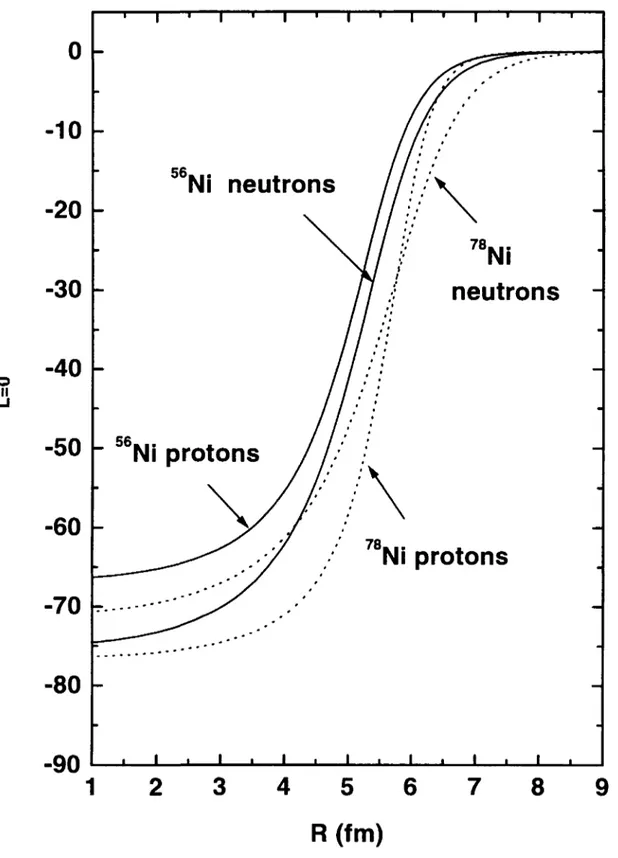HAL Id: in2p3-00021830
http://hal.in2p3.fr/in2p3-00021830
Submitted on 7 Jul 2006HAL is a multi-disciplinary open access archive for the deposit and dissemination of sci-entific research documents, whether they are pub-lished or not. The documents may come from teaching and research institutions in France or abroad, or from public or private research centers.
L’archive ouverte pluridisciplinaire HAL, est destinée au dépôt et à la diffusion de documents scientifiques de niveau recherche, publiés ou non, émanant des établissements d’enseignement et de recherche français ou étrangers, des laboratoires publics ou privés.
Analytically solvable mean-field potential for stable and
exotic nucleic
M.V. Stoitsov, S.S. Dimitrova, S. Pittel, P. van Isacker, A. Frank
To cite this version:
M.V. Stoitsov, S.S. Dimitrova, S. Pittel, P. van Isacker, A. Frank. Analytically solvable mean-field potential for stable and exotic nucleic. Physics Letters B, Elsevier, 1997, 415, pp.1-7. �10.1016/S0370-2693(97)01176-3�. �in2p3-00021830�
iiiiiiiiiiiiiiiiiiiiiiiiiiiiiiiiiiiiiiiiiiiiiiiniiiiii FR9700851
Analytically solvable nuclear mean-field potential
for stable and exotic nuclei
M.V. Stoitsov,1 S.S. Dimitrova,1 S. Pittel,2 P. Van Isacker3 and
A. Frank4 5
'Institute of Nuclear Research and Nuclear Energy. Bulgarian Academy of Sciences. Sofia-1784. Bulgaria
2Bartol Research Institute. University of Delaware. Newark. DE 19716 USA 3GANIL. BP 5027. F-14021 Caen Cedex. France
4Instituto de Ciencias Nucleares. UNAM. AP 70-543. 04510 Mexico DF.
Mexico
5Instituto de Fi'sica. Laboratorio de Cuernavaca. UNAM. AP 139-B.
Cuernavaca. Morelos. Mexico
Analytically solvable nuclear mean-field potential
for stable and exotic nuclei
M.V. Stoitsov,1 S.S. Dimitrova,1 S. Pittel,2 P. Van Isacker,3 and A. Frank45
1 Institute of Nuclear Research and Nuclear Energy, Bulgarian Academy of Sciences, Sofia-1784,
Bulgaria
2Bartol Research Institute, University of Delaware, Newark, DE 19716 USA 3Grand Accelerateur National d'lons Lourds, BP 5027, F-14021 Caen Cedex, France 4Instituto de Ciencias Nucleares, U.N.A.M., A.P. 70-543, 04510 Mexico, D.F., Mexico bInstituto de Fisica, Laboratorio de Cuernavaca, U.N.A.M., A.P. 139-B, Cuernavaca, Morelos,
Mexico
(February 13, 1997)
Abstract
Slater determinants built from the single-particle wave functions of the analytically solvable Ginocchio potential are used to approximate the self-consistent Hartree-Fock solutions for the ground states of nuclei. The results indicate that the Ginocchio potential provides a good parametrization of the nuclear mean field for a wide range of nuclei, including those at the limit of particle stability.
Although the harmonic-oscillator potential is a crude approximation to the true nuclear mean field, it is frequently used in applications of the shell model of atomic nuclei because the radial dependence of its eigenfunctions is known in closed form, allowing an understand-ing of many nuclear properties from a simple—albeit approximate—perspective [1]. More realistic approximations to the nuclear mean field are, of course, available and the most prominent among them, the Woods-Saxon potential, provides a parametrization in terms of a radial extent and a surface diffuseness, allowing a greater flexibility than the single length parameter of the harmonic oscillator. This greater flexibility, however, occurs at the cost of analyticity.
With the advent of experimental facilities that accelerate radioactive species [2], the need for a flexible parametrization of the nuclear mean field becomes all the more pressing. Indeed, with so many more nuclei available for experimental detection a wider variety in the mean-field potential is expected. Much work is currently in progress to develop appropriate theoretical tools for describing nuclei up to the line of particle stability. In light nuclei, extensions of traditional shell-model techniques have confirmed the necessity to modify the single-particle shell-model potential when dealing with nuclei far from stability [3]. In heavier nuclei, the principal developments so far have been in the context of mean-field theory [4] and the use of shell-model techniques [5] will likewise require renewed consideration of an appropriate shell-model potential. Ideally, it should be chosen so as to properly reflect the self-consistent single-particle potential felt by each nucleon, including those modifications that are expected for very weakly bound nucleons near the nuclear surface. Already, some work aimed at analyzing the local equivalent of the full Hartree-Fock (HF) potential in nuclei with a large neutron excess suggests that the potential develops an increasingly large diffuseness as the neutron excess grows [6,7]. Clearly, such phenomena elude a shell-model description based on a harmonic-oscillator potential.
Some time ago, an analytically solvable potential depending on several parameters was introduced by Ginocchio [8]. For certain combinations of these parameters, this potential mimics the usual Woods-Saxon potential with a small diffuseness as occurs in nuclei in
the valley of stability. For other parameter combinations, it admits very different shapes, in some cases reducing to the highly diffuse Poschl-Teller potential familiar in molecular physics. Because of this versatility, the Ginocchio potential may be a useful approximation to the spherical single-particle shell-model potential of nuclei close to as well as far from stability.
In this Letter, we study the possible usefulness of the Ginocchio potential in nuclear struc-ture physics. More specifically, we ask the question: Does a Slater determinant built from the single-particle eigenstates of this potential—with the parameters chosen variationally— reproduce the properties of a self-consistent Hartree-Fock (SCHF) calculation? For the sake of terminology, we refer to this variational procedure to generate the optimum potential as the Ginocchio-Hartree-Fock (GHF) procedure; we also compare its results to a variational procedure (called the harmonic-oscillator Hartree-Fock or HOHF) defined similarly but with reference to harmonic-oscillator single-particle states. This analysis is carried out using a Skyrme hamiltonian and for a representative set of doubly-magic nuclei, including nuclei both within and outside the traditional valley of stability. The comparisons include such key nuclear characteristics as binding energies, density distributions, and rms radii.
The main features of the SCHF theory based on Skyrme-type effective forces are well known [9,10]. The total HF energy, taken as an expectation value of the nuclear Hamil-tonian H over a trial Slater determinant, involves a sum of a Skyrme energy density £sky and a Coulomb energy density £coui- The Skyrme energy density is expressed for spherical even-even nuclei in terms of local nucleon densities, kinetic energy densities, and spin-orbit densities, all defined in terms of the variational single-particle states used to build the Slater determinant. The Coulomb energy density, which depends on the local proton density, con-tains both a direct and an exchange term, the latter usually taken in Slater approximation. To set the stage for a discussion of the GHF procedure, it is useful to make a few brief remarks about the Ginocchio potential [8]. The potential involves four parameters, s, A, o, and i/, which are associated to different geometrical features. Thus, s is the 'scaling parameter', A is the 'shape parameter', a is the 'effective mass parameter' and v is the
'depth parameter'.
In general, each llj shell' of the Ginocchio potential may have its own set of parameters
s, A, a, and i/, which furthermore may be different for neutrons and protons. For any such
choice of the parameters, the potential is analytically solvable. Formulae for its eigenenergies and corresponding eigenvectors are detailed in Ref. [8] and will not be repeated here.
For a variational procedure to be useful, it should not have too many parameters. Thus, while the full parameter flexibility of the Ginocchio potential may be a benefit in some regards, it is a hindrance for our purposes and a limitation in the number of parameters is essential. We will present results of calculations with two sets of variational parameters: (1) In the calculations denoted G4, we assume the four parameters, s, A, a, and is, to be entirely global, with the same values for all neutron and proton single-particle states; (2) More detailed calculations (denoted G8) are for an eight-parameter potential in which we allow distinct parameters for neutrons and protons.
With this as background, the GHF procedure involves (a) evaluating the expectation value of the (Skyrme-type) nuclear Hamiltonian over a Slater determinant built from the Ginocchio single-particle eigenstates as a function of the parameters of the potential (four for G4 and eight for G8), and then (b) minimizing this energy functional with respect to its parameters.
The HOHF procedure is formulated in the same way, the only difference being that the trial Slater determinants are constructed from harmonic-oscillator single-particle wave functions. The energy functional is then minimized with respect to two parameters, the harmonic-oscillator length parameters for neutrons an and for protons ap.
We have carried out HOHF, GHF, and SCHF calculations for a sequence of doubly-magic nuclei. This includes several within the traditional valley of stability - 1 60 , 40Ca, 56Ni, and 208Pb - and one exotic nucleus 78Ni. The HOHF analysis, however, was limited to the nuclei 1 60 , 40Ca and 208Pb. All calculations were based on the original Skyrme parametrization
(SI) [9]. Finally, as in the earliest calculations based on the SI force [9], we omitted the exchange contribution to
Our results for ground-state energies are given in Table I. A few observations are in order. (1) The GHF ground-state energies are lower than those of HOHF, indicating that the Ginocchio wave functions are better in the variational sense than the harmonic-oscillator wave functions. This is not very surprising since the Ginocchio potential (even in the case G4) contains more parameters. The same remark applies when comparing the different calculations based on the Ginocchio potential, namely that the ground-state energies are lower in G8 than in G4. As expected, the SCHF ground-state energies are lower than those in GHF and HOHF because of the variational nature of the calculations. (2) For
N = Z nuclei, there is no significant difference between the G4, and G8 energies. In nuclei
with a substantial neutron excess, however, the G8 calculation is clearly superior. This is also evident from the parameters found in G8 (see Table II): while for iV = Z nuclei the corresponding neutron and proton parameters are nearly equal, there are considerable differences when N > Z. (3) In all the cases considered, the G8 ground-state energies are within 2% of the SCHF results.
Table III gives the corresponding results for neutron and proton rms radii. Similar remarks as for ground-state energies apply. (1) The GHF results are in very good agreement with those of the SCHF procedure, both for light and heavy nuclei. Small deviations, not larger than 0.35%, are seen for the neutron rms radius only. This is in stark contrast to HOHF, where (as expected) significant deviations from SCHF occur. (2) For N = Z nuclei, the calculation G4 suffices; for nuclei with a sizable neutron excess, significant improvements are obtained by allowing different parameters for neutrons and protons (G8).
Fig. 1 shows the neutron and proton local density distributions for several of the stable doubly-magic nuclei we have considered. The GHF results were obtained with the G8 parametrization of the Ginocchio potential. We make the following observations: (1) The GHF and SCHF densities agree almost perfectly in the surface region. The main reason is that the Ginocchio wave functions have an appropriate exponential fall off, as shown in [8]. In contrast, as is also evident from Fig. 1, the Gaussian asymptotic behavior of harmonic-oscillator wave functions leads to significant deviations in the HOHF surface density from
that in SCHF. This observation also explains the nice GHF results for binding energies and rms radii. Since the densities and energy densities are weighted by r2dr, the main contribution to these nuclear characteristics comes from the nuclear surface, where GHF is evidently superior to HOHF. The fact that the GHF procedure reproduces nuclear properties
in the surface region so accurately suggests that the single-particle wave functions so obtained should be especially suitable in shell-model studies. (2) The HOHF and GHF densities
differ significantly from the SCHF results at small r, namely in the region of density shell oscillations. Both HOHF and GHF exhibit oscillations at small r that are too large - the former more so than the latter - especially for heavier nuclei. An improvement in the GHF local densities at small r might perhaps be achieved by permitting different v parameters for single-particle states with j = I + | and j = / — \.
To study the effect of a neutron excess, we compare in Fig. 2 the neutron and proton local density distributions in 56Ni and 78Ni as obtained in the GHF calculation G8. The Ginocchio
potential is able to accommodate nuclei with very different densities, ranging from those in which the neutron and proton densities are nearly identical to others where the neutrons develop a 'skin'. The corresponding s-wave potentials for neutrons and protons are shown in Fig. 3. Note the difference in shape of the two potentials in 78Ni: the neutron potential
has 'softer' edges, resembling a Poschl-Teller (or perhaps a highly-diffuse Woods-Saxon) potential.
In summary, we have studied the possible usefulness of the Ginocchio potential as an ef-fective local potential for the shell model by comparing the results of variational calculations based on Slater determinants built from such wave functions with those of self-consistent HF. The results are very encouraging. They suggest that the GHF method is able to repro-duce remarkably well the full HF results, especially in the vicinity of the nuclear surface, all the while keeping a relatively simple analytic form for the potential. Most importantly, the Ginocchio potential seems be equally suitable for traditional stable nuclei and for rela-tively weakly-bound nuclei far from stability. This opens up the possibility of meaningfully extending the shell-model methodology to exotic nuclei.
In the future, we plan to look into the possible use of more realistic effective hamiltonians, including both improved zero-range interactions of the Skyrme type [4] as well as finite-range interactions [11]. When dealing with finite-range interactions, the self-consistent HF poten-tial is difficult to cast in local form, so that our procedure may turn out to be particularly useful there. In that context, the connection of our approach to recent work of relevance to atomic clusters [12] should be noted. Eventually, we would like to apply these methods to (spherical) open-shell nuclei as well, where it will be necessary to include BCS pairing correlations. We should, of course, include the exchange contribution to the Coulomb energy in fully realistic applications. Finally, we also plan to investigate the relation between our proposed GHF method and the Extended Thomas Fermi approximation [13].
This work was supported in part by the National Science Foundation under Grant Nos. PHY-9600445 and INT-9415876, by the Bulgarian National Foundation for Scientific Research under contract No. $-527, by the French Centre National de Recherche Scien-tifique, by DGAPA-UNAM under project IN105194 and by the European Union under contract No. CIl*-CT94-0072. The authors wish to acknowledge fruitful discussions with W. Nazarewicz, D. Dean, W. Satula, M. Ploszajczak and J. Dukelsky.
REFERENCES
[1] I. Talmi, Simple Models of Complex Nuclei. The Shell Model and Interacting Boson
Model, (Harwood, 1993), chapter 29.
[2] A.C. Mueller and B.M. Sherrill, Ann. Rev. Nucl. Part. Sci. 43, 529 (1993). [3] T. Otsuka, N. Fukunishi, and H. Sagawa, Phys. Rev. Lett. 70, 1385 (1993). [4] J. Dobaczewski, H. Flocard, and J. Treiner, Nucl. Phys. A 422, 103 (1984). [5] J. R. Bennett, J. Engel, and S. Pittel, Phys. Lett. B 368, 7 (1996); 2013 (1993). [6] J. Dobaczewski, W. Nazarewicz, T.R. Werner, J.F. Berger, C.R. Chinn, and J. Decharge,
Phys. Rev. C 53, 2809 (1996).
[7] N. Fukunishi, T. Otsuka, and I. Tanihata, Phys. Rev. C 48, 1648 (1993). [8] J.N. Ginocchio, Ann. Phys. 159, 467 (1985).
[9] D. Vautherin and D.M. Brink, Phys. Rev. C 5, 626 (1972).
[10] M. Brack, C. Guet, and H.-B. Hakansson, Phys. Rep. 123, 275 (1985). [11] J. Decharge and D. Gogny, Phys. Rev. C 21, 1568 (1980).
[12] Aurel Bulgac, Caio Lewenkopf, and Vadim Mickrjukov, Phys. Rev. B 52, 16476 (1995). [13] F. Tondeur, M. Brack, M. Farine, and J.M. Pearson, Nucl. Phys. A 420, 297 (1984).
FIGURES
FIG. 1. Neutron pn{T) and proton pp{r) local density distributions as obtained in HOHF
(dot-ted), GHF/G8 (dashed), and SCHF (solid) calculations.
FIG. 2. Neutron pn{r) and proton pp{r) local density distributions in 56Ni (solid) and 78Ni
(dotted) as obtained in the GHF calculation G8.
FIG. 3. The a-wave potential for neutrons and protons in 56Ni (solid) and 78Ni (dotted)
TABLES
TABLE I. Results for ground-state energies E (in MeV)
1 6Q 4 0Ca 5 6N i 7 8N i 208pb sp
K
an ap Vn "p HOHF -128.2 -331.5 --1469.3TABLE II. Variational
16Q 0.106 0.105 3.678 3.714 0.193 0.151 3.452 3.400 G4 -129.9 -341.3 -489.8 -646.4 -1598.6 E parameters as obtained in 4 0Ca 0.067 0.064 4.627 4.878 0.138 0.131 4.878 4.447 5 6N i 0.069 0.066 3.917 4.138 0.004 0.000 6.545 6.029 G8 -130.0 -341.6 -489.8 -649.0 -1609.2 the GHF calculation G8a 7 8N i 0.066 0.042 3.784 6.097 0.000 0.124 6.895 6.504 SCHF -131.5 -345.6 -498.7 -660.7 -1641.1 208pb 0.033 0.022 5.740 9.033 0.000 0.001 9.488 8.434 The parameters sn, sp, an, and ap are in fm 1; other parameters are dimensionless.
TABLE HI. Results for the neutron and proton rms radii Rn and Rp (in fm) 1 6 Q 40Ca 5 6N i 7 8Ni 208pb HOHF 2.56 3.32 — — 5.58 Rn G4 2.55 3.29 3.59 4.08 5.51 G8 2.54 3.27 3.57 4.05 5.47 SCHF 2.53 3.27 3.56 4.07 5.49 HOHF 2.58 3.36 — — 5.47 R, G4 2.55 3.29 3.59 3.82 5.32 p G8 2.56 3.31 3.62 3.86 5.38 SCHF 2.56 3.31 3.61 3.85 5.38 11
Fig. 1
0.10 0.10
2 3 4 5 6 7 8



